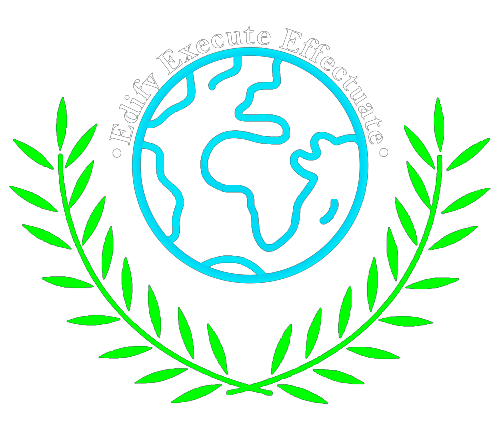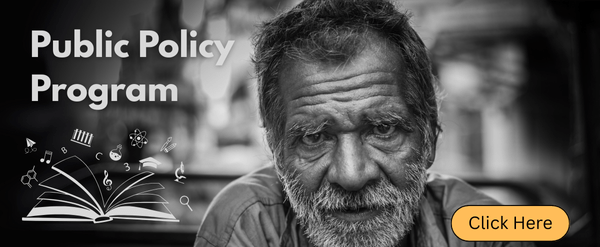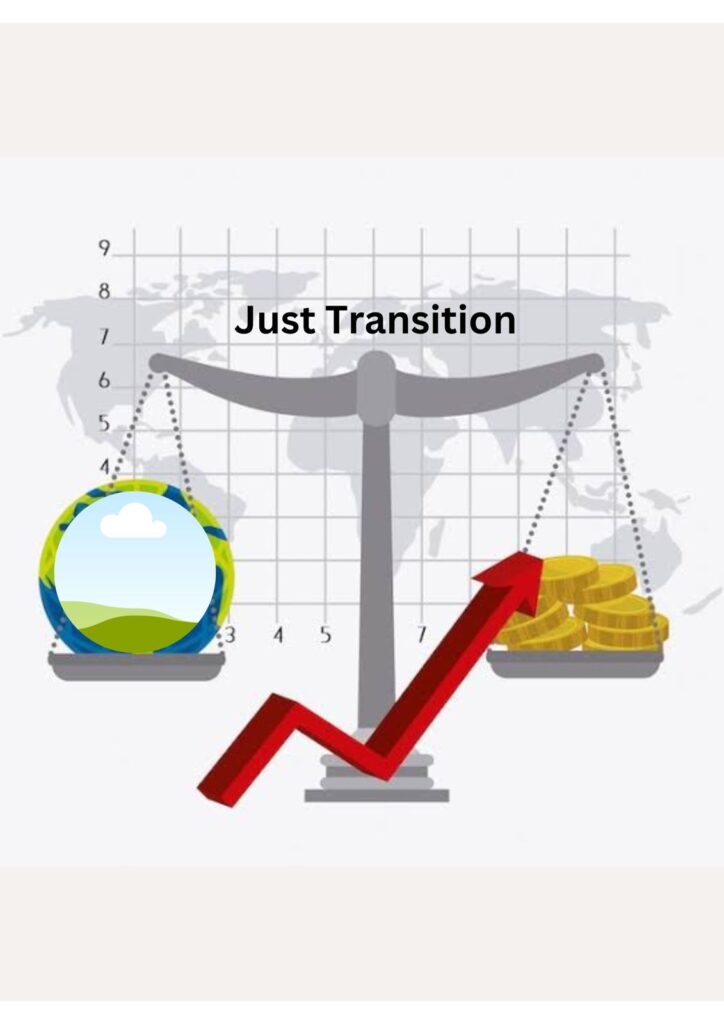The Hidden Costs of Climate Action: Economic Inequality and Just Transition
By – Ekta
Introduction
As global efforts to address climate change gain momentum, the concept of a “just transition” has emerged as an essential framework. This approach aims to ensure that the transition towards a green economy is both inclusive and equitable, ensuring that no community is left behind. However, economically disadvantaged communities often encounter significant challenges during this transition, primarily due to limited resources, job insecurity, and restricted access to green technologies. It is imperative to address these disparities to create a truly inclusive and sustainable future for all (Johnsson, 2023).
The Idea of a Just Transition
The concept of a just transition has its roots in labor movements that advocated for the equitable treatment of workers affected by economic transformations. In the context of climate action, a just transition aims to safeguard the livelihoods of workers and communities that rely on traditional industries as these sectors evolve towards more sustainable practices. However, economic disparities among communities indicate that certain groups, particularly those with limited resources, bear a disproportionate burden when adapting to these changes. If not approached with intentionality, a just transition risks exacerbating existing inequalities, potentially benefiting wealthier segments of society while economically disadvantaged communities are left to navigate additional challenges(UNDP, 2022). Therefore, The question remains: “Just transition for whom?” It is imperative to identify the most vulnerable groups, as this is crucial for effectively managing the transition (Wang & Lo, 2021).
How Economic Inequality Exacerbates the Transition
- Climate Vulnerability and Economic Disparity
Economically disadvantaged communities are often situated in areas that are more vulnerable to the impacts of climate change, such as flood-prone regions or urban heat islands. These communities frequently face significant challenges in accessing the resources necessary to effectively respond to extreme weather events. Their limited financial flexibility further exacerbates their difficulties in adapting to these changes. In contrast, wealthier communities have the means to implement protective measures, resulting in a situation where lower-income groups experience heightened exposure to climate-related risks and face greater obstacles in recovering from them. This disparity highlights the critical importance of prioritizing justice for those most at risk from both climate change and the fossil fuel economy (Kashwan & Prakash, 2022). Historical socio-ecological inequalities, many of which can be traced back to colonialism, continue to impact communities today. This is particularly evident in Adivasi populations adversely affected by coal extraction practices in India. Furthermore, the rising suicide rates associated with economic and climate-related challenges highlight a significant correlation between climate vulnerability and economic disparity (Lawrance et al., 2022). Access to green technology poses a barrier: in rural India, solar energy is more accessible to wealthier and higher-caste households, thus reinforcing existing inequalities(Haldar et al., 2023).
- Access to Green Technologies
The significant upfront costs associated with green technologies, such as solar panels and electric vehicles, present a considerable barrier for low-income households. Despite available incentives, these technologies often remain financially inaccessible for many, hindering comprehensive participation in the green economy. While wealthier individuals can reap the benefits of long-term savings, lower-income households frequently continue to rely on conventional energy sources. In the absence of targeted financial assistance, the existing disparities in access to sustainable energy solutions are likely to widen, exacerbating social inequality (Healy & Berry, 2017).
- Job Loss and Economic Insecurity
The transition to a low-carbon economy presents substantial challenges, particularly for workers in the fossil fuel sector who may face job displacement and financial instability. Although the renewable energy sector has the potential to create green jobs, access to these opportunities may be limited for marginalized communities. Additionally, declining fossil fuel industries can lead to reduced local tax revenues, which may adversely affect vital public services, such as education and healthcare. For example, Jharkhand, a state in India that relies heavily on non-renewable resources, is experiencing significant livelihood losses due to this transition. This situation underscores the urgent need for alternative employment frameworks to address economic displacement effectively (Habib et al., 2023).
- Rising Costs of Living and Economic Strain
Sustainability policies can inadvertently impose a disproportionate financial burden on low-income communities. As the transition to green energy sources leads to rising energy costs, economically disadvantaged groups may find themselves allocating a larger percentage of their income to utility expenses. In contrast, more affluent households typically have the financial flexibility to absorb these increases. Consequently, low-income families may be forced to make difficult trade-offs, potentially sacrificing essential needs such as food, healthcare, and education. This situation can perpetuate a cycle of financial strain, where economically disadvantaged communities experience the negative impacts of sustainability initiatives without enjoying their corresponding benefits (Haldar et al., 2023). Additionally, the complexity of application processes and stringent eligibility requirements can further limit access to financial assistance, effectively excluding low-income households from fully participating in the green transition.
Solutions for a Fairer Transition
Governments can design financial assistance programs to address economic barriers, such as subsidies for green technology. Streamlining application processes and broadening eligibility criteria can ensure that these resources effectively reach those most in need, thereby enabling economically disadvantaged communities to actively participate in sustainability initiatives (Anjanappa & Samant, 2024).
Moreover, supporting community-led sustainability projects empowers these communities to address their unique challenges effectively. For example, community solar programs enable low-income families to benefit from renewable energy through shared installations, which not only creates jobs but also fosters a sense of ownership within the community.
A just transition involves establishing an inclusive green economy that provides decent employment opportunities for all members of society (International Labour Organisation, 2024). Equitable job training programs should prioritize economically disadvantaged workers by offering affordable education and skills development in green industries. Furthermore, providing stipends or financial assistance during retraining periods can alleviate economic pressures, allowing individuals to concentrate on acquiring essential skills for new opportunities.
Progressive climate policies, such as sliding-scale subsidies, can help mitigate the financial burden on low-income families. Implementing tiered energy pricing can lower utility costs, making green energy more accessible. Additionally, tax incentives for home upgrades should incorporate options for direct financial support, thereby reducing the necessity for upfront investments (Velicu & Barca, 2020).
Conclusion
A just transition is essential for attaining a sustainable future; however, if not approached with care, it may disproportionately affect economically disadvantaged communities. It is vital to acknowledge and address the unique challenges these communities encounter to ensure that no one is overlooked in this process. By implementing targeted financial support, fostering community-led initiatives, and promoting inclusive policymaking, we can facilitate a just and equitable transition. This approach will contribute to the development of a green economy that benefits all members of society.
References
Wang, Xinxin., et Lo, Kevin,. (2021). Just transition: A conceptual review. Just transition: A conceptual review – ScienceDirect
Johansson, Vilja. (2023). Just Transition as an evolving concept in International Climate Law. Just Transition as an Evolving Concept in International Climate Law | Journal of Environmental Law | Oxford Academic
Haldar, Stuti., Peddibhotla, Ananya., et al. (2023). Analyzing intersections of justice with energy in India – A Systematic literature review. Analysing intersections of justice with energy transitions in India – A systematic literature review – ScienceDirect
United Nations Development Programme. (2022) What is just transition? And why is it important?
What is just transition? And why is it important? | Climate Promise
Wang, Xinxin., Lo, Kevin., (2022). Political economy of just transition: Disparate impact of coal mine closure on state-owned and private coal workers in Inner Mongolia, China. Political economy of just transition: Disparate impact of coal mine closure on state-owned and private coal workers in Inner Mongolia, China – ScienceDirect
Velicu, Irina et Barca, Stefania,. (2020). The Just Transition and its work of inequality. https://www.tandfonline.com/doi/pdf/10.1080/15487733.2020.1814585%40tsus20.2020.17.issue-S2
Krawchenko Antonia Tamara, et Mehan Gordon., (2021). How do we manage a just transition? A Comparative Review of National and Regional Just Transition Initiatives. How Do We Manage a Just Transition? A Comparative Review of National and Regional Just Transition Initiatives
Abram, Simone., Atkins, Ed., et al. (2022). Just Transition: A whole-systems approach to decarbonization. https://doi.org/10.1080/14693062.2022.2108365
Bainton, Nicholas., Kemp, Dean., Lebre, Eleonore., Owen, John, R. Owen. (2021) The energy-extractives nexus and the just transition. https://onlinelibrary.wiley.com/doi/pdf/10.1002/sd..2163
Wood, Nathan., et Roelich, Katy. (2021). Substantiating Energy Justice: Creating a Space to Understand Energy Dilemmas. https://www.mdpi.com/2071-1050/12/5/1917
Anjanappa, Janaradhana., et Samant, Sheighar. (2023). How Inclusive is the Clean Energy Transition in India. How Inclusive is the Clean Energy Transition in India? by Janardhana Anjanappa, Shridhar Samant :: SSRN
Mulvaney, Dustin., et Newell, Peter., (2013). Political Economy of the Just Transition. https://www.researchgate.net/profile/Dustin-Mulvaney/publication/259043435_The_Political_Economy_of_the_Just_Transition/links/59e3a090a6fdcc7154dbadd7/The-Political-Economy-of-the-Just-Transition.pdf
Climate justice in India [Book] edited by Prakash Kashwan.
Cambridge University Press, 2022. Pp.xx + 249; index. open access (e-book). $135 (hardback). ISBN 9781009171915 (hardback). ISBN 9781009171908 (e-book) https://www.tandfonline.com/doi/full/10.1080/09644016.2023.2216102
International Labour Organization. (2024). Climate change and financing for a just transition. Climate change and financing a just transition | International Labour Organization
Healy, Noel., Barry, John., (2017). Politicizing energy justice and energy system transitions: Fossil fuel divestment and a “just transition.
https://www.sciencedirect.com/science/article/abs/pii/S0301421517303683






